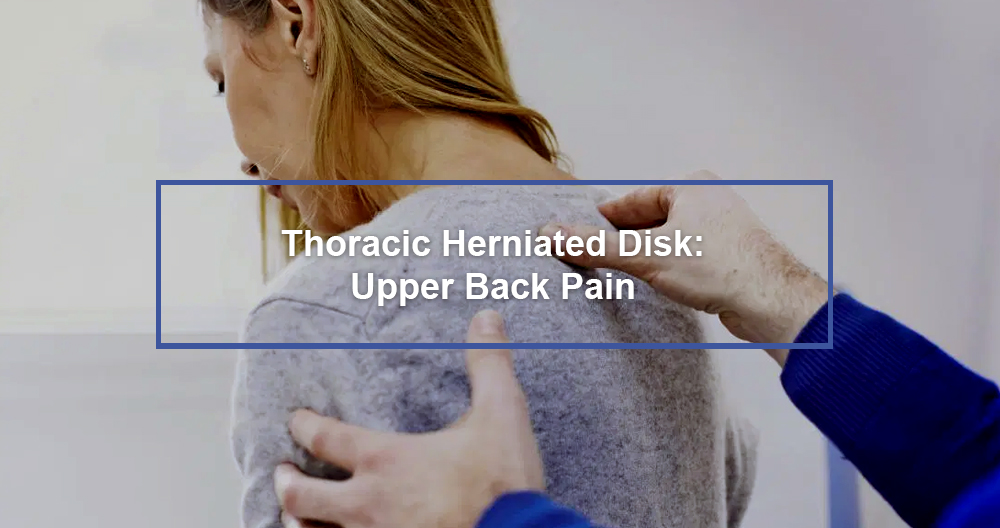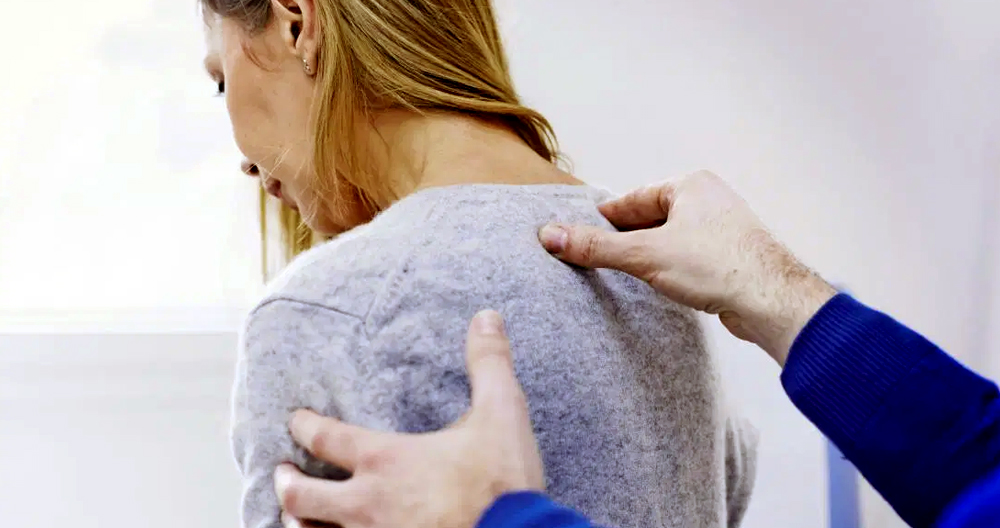
A herniated upper disc (also known as a “thoracic herniated” disc) can cause pain, weakness, and numbness. The most common sign and symptom is sharp, axial pain in the back that worsens with activity.
- It is a burning or electric-like sensation that radiates from the abdomen or chest.
- Similar, shock-like pains can radiate into your legs.
- Sensory disturbances including tingling or numbness can be felt at the herniated disc’s level.
- You can also observe motor deficits like leg weakness or gait instability.
- Paralysis of the legs and bowel dysfunction can result in severe cases.
An intervertebral disc’s inner gelatinous substance can leak out from the disc, leading to a herniated disc in the upper spine. A herniated disc thoracic can cause upper back pain, as well as other symptoms such radiating pain or numbness.
The specific symptoms of a thoracic herniated disc are different depending upon where it is located. As the herniated material in the upper spine can impinge on an exiting neuro root or the spinal cord, there may be other symptoms.
Thoracic Degenerative Disc disease
Although thoracic disc diseases are conceptually similar to disc conditions in the cervical and the lumbar spines (disc disorders), symptomatic lesions, which refer to anatomical problems that cause the symptoms, are much less common.
Thoracic disc problems are most common at the thoracolumbar, which is the junction of the lumbar and thoracic parts of the spine column (T8-T12), in the mid-back. Many thoracic disc disorders are not associated with thoracic pain, or any other symptoms.
A study was done in which 90 patients with no symptoms or pain underwent thoracic MRI scanning. These were the conclusions:
73% of patients were diagnosed with disc abnormalities in the upper spine, such as a thoracic herniated disc or thoracic disc degenerative disease.
37% had a thoracic disc herniated specifically
29% of the patients had radiographic evidence showing spinal cord impingement on the MRI.
These patients were monitored for 26 months, and none developed thoracic pain due to their thoracic disc disorders.
Pain due to a herniated disc thoracic
Twelve intervertebral discs are located in the thoracic spinal spine and support the vertebrae in mid-back.1 A herniated disc occurs when the disc’s outer layer (annulus fibrosus), tears, and the jelly-like inner (nucleus pulposus), bulges out or becomes extruded.
Thoracic herniated discs can lead to various types of pain, such as:
Discogenic pain. Back pain that is localized to the injury level may occur when the annulus fibrosus ruptures or tears. This type of pain may be misinterpreted to mean abdominal, pulmonary or cardiac pain.
Muscle spasm. Local injuries to the intervertebral and supporting ligaments may trigger protective responses from the surrounding muscles. The muscles of the back, which are large, can become tighter and eventually spasm. Spasms in the muscles can cause pain across multiple levels of your back. This can limit motion and make it difficult to stand.
Radicular pain. Radicular pain can be caused by a herniated disc in the thoracic area. It is most common to feel burning, electric shock-like pain. However it can also feel mild and achy. Sometimes, the pain can feel like a band around one’s abdomen or chest.
Treatments
The surgeon may recommend these non-operative options before considering surgery.
- Activity modification
- Patient education about proper body mechanics (to reduce the possibility of disc damage or pain)
- Physical therapy may include ultrasound, massage and conditioning.
- Weight control
- Medications (to reduce inflammation and control pain, as well as relax muscles)
- These are the principles that will guide your surgeon when treating a herniated disc.
The history, severity and duration of your pain
- How effective and whether the patient has had any previous treatment for disc problems
- Assess whether or not there is evidence of neurologic injury such as sensory loss or weakness, impaired coordination, bowel problems, or bladder problems
- For patients suffering from disc disorders of their spine, surgery is recommended if the patient does not experience relief after non-operative treatment for 6-12 weeks. If there is a neurologic problem (numbness, weakness or reduced function due pressure on the nerves or spinal cord), surgery may be recommended. For these cases, early intervention is the best way to maximize the chance of neurologic recovery.
The following procedures may be performed by your surgeon:
- Microdiscectomy is a procedure that uses a microscope with microsurgical tools to remove a portion of the disc pressing against the nerve. This relieves the pressure created by a herniated or bulging disc. Microdiscectomy can be performed to remove herniated cervical, thoracic or lumbosacral discs. The procedure can be performed under general anesthesia using a small cut to the skin. The spine muscles can be gently raised or pulled apart to expose a small portion of it. Under high magnification, the microscope allows safe access to your spinal canal. To do this, a small section of the spine’s back called the lamina/facet joint is removed. Our neurosurgeons remove the herniated portion of the disc using microsurgical techniques while protecting the compressed nerves. Most patients can return home within 24 hours of their surgery.
- Large or calcified thoracic disc herniations can cause spinal cord compression. This may require either an anterior or lateral surgical approach.
- Anterior Cervical Fusion and Discectomy (ACDF): This is a procedure in which the herniated disc from the cervical spine is removed through the front. The spine may need to be stabilized by spinal fusion surgery after the discectomy.

